Archimedean Solids
Archimedean
solids are convex polyhedra composed out of (nonintersecting)
regular polygons with each vertex having the same configuration of
polygons of more than one type. There are 13 of them, ranging from simple
to complex, and I've built them all.
Cuboctahedron
The cuboctahedron
is composed out of 8 triangular and 6 square faces. It has 12 vertices
and 24 edges. The most economic way to build it is to use short
bars for the edges and to support each square face with a long bar,
which requires 12 spheres, 24 short bars and 6 long bars. If long
bars are used as edges, it is necessary to support the square faces
with 4-stars of short bars, which requires 18 spheres, 24 short bars,
and 24 long bars.
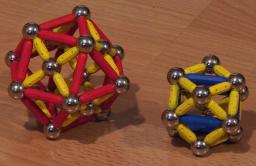
Snub Cube
The snub cube
is composed out of 32 triangular and 6 square faces. It has 24 vertices
and 60 edges. The simplest approach to building a snub cube is to
use short bars for the edges and to support the square faces with
one long bar each, which requires 24 spheres, 60 short bars and 6 long
bars. If long bars are used as edges, the square faces should be
supported by 4-stars of short bars, which requires 30 spheres,
24 short bars, and 60 long bars.

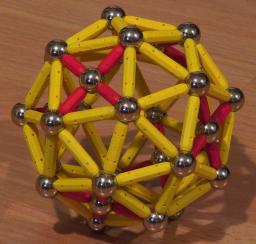
Small Rhombicuboctahedron
The
small rhombicuboctahedron is composed out of 8 triangular and
18 square faces. It has 24 vertices and 48 edges. It can be built
by using short bars as edges, in which case the square faces must be
supported by a long bar each. This construction requires 24 spheres,
48 short bars and 18 long bars. If long bars are used as edges, the
square faces should be supported by 4-stars of short bars, which
requires 42 spheres, 72 short bars, and 48 long bars.
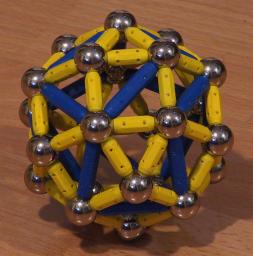
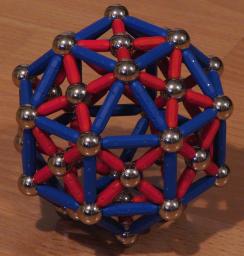
Icosidodecahedron
The
icosidodecahedron is composed out of 20 triangular and 12
pentagonal faces. It has 30 vertices and 60 edges. The standard
construction, by using 5-stars to support the pentagonal faces,
requires 42 spheres and 120 bars.

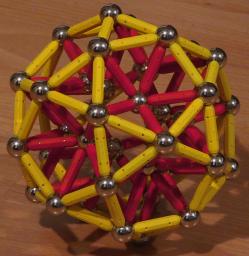
Snub Dodecahedron
The
snub dodecahedron consists of 80 triangular and 12 pentagonal
faces. It has 60 vertices and 150 edges. If built with 5-stars to
support the pentagonal faces, it requires 72 spheres and 210 bars.
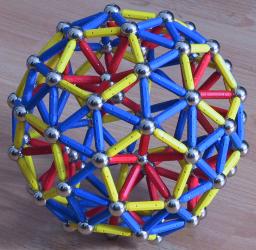
A long snub dodecahedron. Yellow bars are used for the edges of the
pentagons, blue bars for all the other edges of the polyhedron. Red
bars are used to stabilize the pentagons.
Small Rhombicosidodecahedron
The
small rhombicosidodecahedron consists of 20 triangular, 30 square,
and 12 pentagonal faces. It has 60 vertices and 120 edges. If built with
short bars, the standard construction uses 72 spheres, 180 short bars, and
30 long bars. The long version uses 102 spheres, 120 short bars, and
180 long bars.
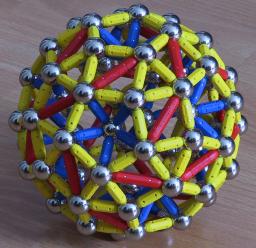
A short small rhombicosidodecahedron. Yellow bars are used for the
edges of the polyhedron, blue bars for stabilizing the pentagons and
long red bars for stabilizing the squares.
Truncated Tetrahedron
The
truncated tetrahedron consists of 4 triangular and 4 hexagonal faces.
It has 12 vertices and 18 edges. If 6-stars are used to stabilize the
hexagons, its construction uses 16 spheres and 42 bars.
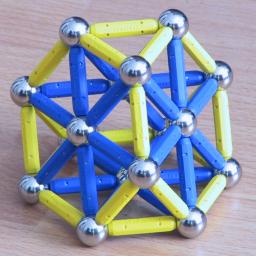
Truncated Octahedron
The
truncated octahedron consists of 6 square and 8 hexagonal faces.
It has 24 vertices and 36 edges. The standard construction with short
bars requires 32 spheres, 84 short bars, and 6 long bars. With long
bars used as edges, it requires 38 spheres, 24 short bars, and 84 long
bars.
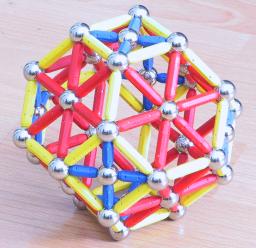
Truncated Icosahedron
The
truncated icosahedron consists of 12 pentagonal and 20 hexagonal
faces. It has 60 vertices and 90 edges. It's the shape used for the
construction of soccer balls. If 5-stars are used for stabilizing the
pentagons and 6-stars for the hexagons, it requires 92 spheres and
270 bars for its construction.
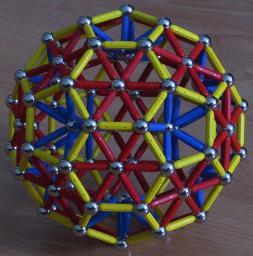
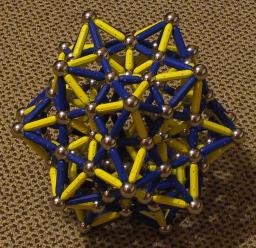
The short truncated icosahedron in the second picture uses long bars
for the stabilizations of its hexagons, and the resulting pyramids are
turned to the outside.
Truncated Cube
The
truncated cube consists of 8 triangular and 6 octagonal
faces. It has 24 vertices and 36 edges. The standard construction
with short bars does not work because it gets too dense. With long
bars, it requires 30 spheres, 48 short bars, and 84 long bars.
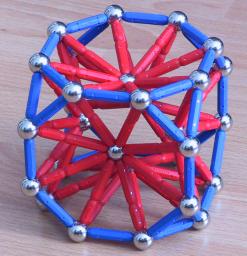
Great Rhombicuboctahedron
The
great rhombicuboctahedron consists of 12 square, 8 hexagonal, and
6 octagonal faces. It has 48 vertices and 72 edges. The standard
construction with short bars requires 62 spheres, 120 short bars, and
48 long bars. With long bars, it requires 74 spheres, 84 short bars, and
168 long bars.
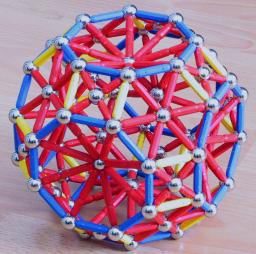
Truncated Dodecahedron
The
truncated dodecahedron consists of 20 triangular and 12
decagonal (10-sided) faces. It has 60 vertices and 90 edges. If
it is built by supporting the decagonal faces with an embedded
pentagon each, it requires 132 spheres and 330 bars.
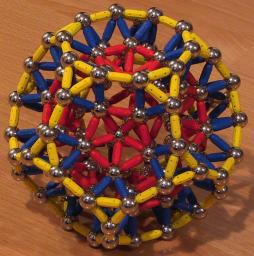
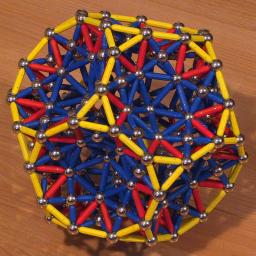
Great Rhombicosidodecahedron
The
great rhombicosidodecahedron consists of 30 square, 20 hexagonal, and
12 decagonal faces. It has 120 vertices and 180 edges. If it is built
with short bars as edges, the square sides can be supported by a long
bar each, the hexagonal faces by 6-stars of short bars and the decagonal
faces by embedded pentagons. This construction requires 212 spheres,
480 short bars, and 30 long bars. If built with long bars as edges, it
requires 242 spheres, 120 short bars, and 480 long bars.
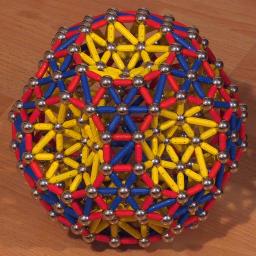

The long version was rendered with POV-Ray. The
model was constructed with my own software.


















